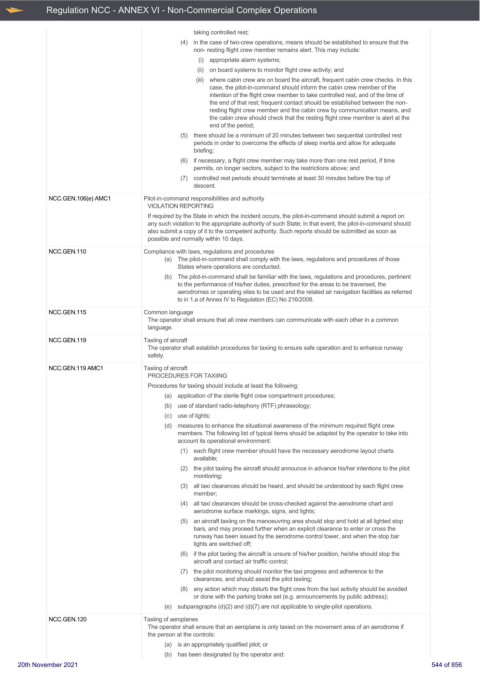Page 544 - UK Air Operations Regulations 201121
P. 544
~
~ Regulation NCC - ANNEX VI - Non-Commercial Complex Operations Centrik
taking controlled rest;
(4) in the case of two-crew operations, means should be established to ensure that the
non- resting flight crew member remains alert. This may include:
(i) appropriate alarm systems;
(ii) on board systems to monitor flight crew activity; and
(iii) where cabin crew are on board the aircraft, frequent cabin crew checks. In this
case, the pilot-in-command should inform the cabin crew member of the
intention of the flight crew member to take controlled rest, and of the time of
the end of that rest; frequent contact should be established between the non-
resting flight crew member and the cabin crew by communication means, and
the cabin crew should check that the resting flight crew member is alert at the
end of the period;
(5) there should be a minimum of 20 minutes between two sequential controlled rest
periods in order to overcome the effects of sleep inertia and allow for adequate
briefing;
(6) if necessary, a flight crew member may take more than one rest period, if time
permits, on longer sectors, subject to the restrictions above; and
(7) controlled rest periods should terminate at least 30 minutes before the top of
descent.
NCC.GEN.106(e) AMC1 Pilot-in-command responsibilities and authority
VIOLATION REPORTING
If required by the State in which the incident occurs, the pilot-in-command should submit a report on
any such violation to the appropriate authority of such State; in that event, the pilot-in-command should
also submit a copy of it to the competent authority. Such reports should be submitted as soon as
possible and normally within 10 days.
NCC.GEN.110 Compliance with laws, regulations and procedures
(a) The pilot-in-command shall comply with the laws, regulations and procedures of those
States where operations are conducted.
(b) The pilot-in-command shall be familiar with the laws, regulations and procedures, pertinent
to the performance of his/her duties, prescribed for the areas to be traversed, the
aerodromes or operating sites to be used and the related air navigation facilities as referred
to in 1.a of Annex IV to Regulation (EC) No 216/2008.
NCC.GEN.115 Common language
The operator shall ensure that all crew members can communicate with each other in a common
language.
NCC.GEN.119 Taxiing of aircraft
The operator shall establish procedures for taxiing to ensure safe operation and to enhance runway
safety.
NCC.GEN.119 AMC1 Taxiing of aircraft
PROCEDURES FOR TAXIING
Procedures for taxiing should include at least the following:
(a) application of the sterile flight crew compartment procedures;
(b) use of standard radio-telephony (RTF) phraseology;
(c) use of lights;
(d) measures to enhance the situational awareness of the minimum required flight crew
members. The following list of typical items should be adapted by the operator to take into
account its operational environment:
(1) each flight crew member should have the necessary aerodrome layout charts
available;
(2) the pilot taxiing the aircraft should announce in advance his/her intentions to the pilot
monitoring;
(3) all taxi clearances should be heard, and should be understood by each flight crew
member;
(4) all taxi clearances should be cross-checked against the aerodrome chart and
aerodrome surface markings, signs, and lights;
(5) an aircraft taxiing on the manoeuvring area should stop and hold at all lighted stop
bars, and may proceed further when an explicit clearance to enter or cross the
runway has been issued by the aerodrome control tower, and when the stop bar
lights are switched off;
(6) if the pilot taxiing the aircraft is unsure of his/her position, he/she should stop the
aircraft and contact air traffic control;
(7) the pilot monitoring should monitor the taxi progress and adherence to the
clearances, and should assist the pilot taxiing;
(8) any action which may disturb the flight crew from the taxi activity should be avoided
or done with the parking brake set (e.g. announcements by public address);
(e) subparagraphs (d)(2) and (d)(7) are not applicable to single-pilot operations.
NCC.GEN.120 Taxiing of aeroplanes
The operator shall ensure that an aeroplane is only taxied on the movement area of an aerodrome if
the person at the controls:
(a) is an appropriately qualified pilot; or
(b) has been designated by the operator and:
20th November 2021 544 of 856

